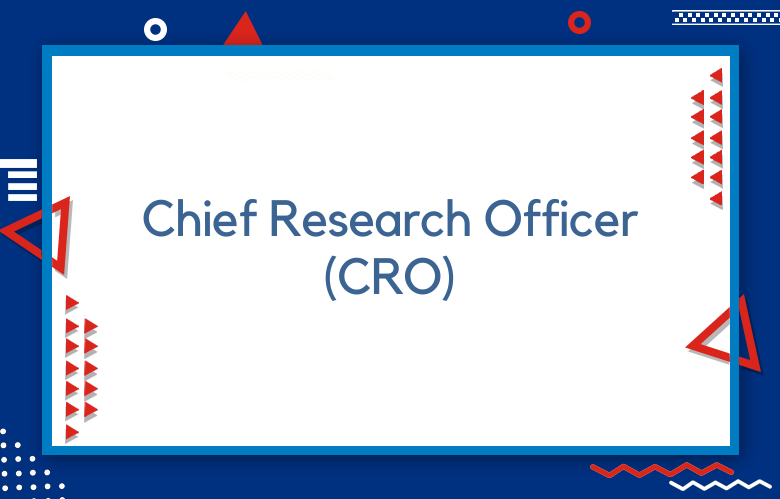Chief Research Officer (CRO) Role and Responsibilities

The Chief Research Officer (CRO) is a senior executive who oversees an organization’s research and development activities. The CRO plays a critical role in driving innovation and growth and ensuring that the organization remains at the forefront of its industry.
Chief Research Officer (CRO) Role and Responsibilities
The CRO’s role is critical in driving organizational innovation and growth. By developing and implementing a comprehensive research and development strategy, leading and managing a team of researchers and engineers, and collaborating with other departments, the CRO can help ensure that the organization remains at the forefront of its industry and continues to deliver value to its customers.
The responsibilities of the CRO typically include:
- Developing and implementing a comprehensive research and development strategy aligning with the organization’s objectives and priorities.
- We lead and manage a team of researchers, scientists, and engineers to drive innovation and develop new products, services, and technologies.
- We are collaborating with other departments, such as marketing and sales, to ensure that research and development initiatives are aligned with market needs and opportunities.
- She oversees the organization’s intellectual property portfolio, including patents, trademarks, and copyrights.
- We are identifying and pursuing partnerships and collaborations with other organizations to enhance the organization’s research and development capabilities.
- Monitoring industry trends and developments ensures that the organization remains at the forefront of its industry.
Unraveling the Role of the Chief Research Officer (CRO)
The Chief Research Officer (CROcriticals) is a critical executive position in an organization responsible for overseeing the research and development (R&D) function. The CRO plays a crucial role in driving innovation and growth by fostering a culture of research and development within the organization.
The CRO’s primary responsibilities include developing and implementing a research and development strategy that aligns with the organization’s overall objectives and priorities. This involves leading and managing a team of researchers, scientists, and engineers to drive innovation and develop new products, services, and technologies.
The CRO must also collaborate with other departments, such as marketing and sales, to ensure that research and development initiatives are aligned with market needs and opportunities. Additionally, they oversee the organization’s intellectual property portfolio and identify and pursue partnerships and collaborations with other organizations to enhance its research and development capabilities.
The Evolving Landscape: Exploring the Responsibilities of a Chief Research Officer (CRO)
The Chief Research Officer (CRO) role has evolved significantly in recent years, reflecting the changing landscape of research and development in various industries. As organizations increasingly recognize the importance of innovation and growth, the CRO’s responsibilities have expanded to encompass a broader range of strategic and operational activities.
The CRO’s primary responsibilities include developing and implementing a research and development strategy that aligns with the organization’s overall objectives and priorities. This involves leading and managing a team of researchers, scientists, and engineers to drive innovation and develop new products, services, and technologies.
However, the CRO’s role now extends beyond the traditional R&D function. The CRO must collaborate with other departments, such as marketing and sales, to ensure that research and development initiatives are aligned with market needs and opportunities. They must also oversee the organization’s intellectual property portfolio, identify and pursue partnerships and collaborations with other organizations, and monitor industry trends and developments to ensure that the organization remains at the forefront of its industry.
From Data to Strategy: The Crucial Role of the Chief Research Officer (CRO)
In today’s data-driven world, the Chief Research Officer (CRO) role has become increasingly crucial in driving organizational success. As organizations collect and analyze vast amounts of data, the CRO plays a critical role in transforming this data into actionable insights that inform strategic decision-making.
The CRO is responsible for developing and implementing a comprehensive research strategy aligning with the organization’s objectives and priorities. This involves leading and managing a team of researchers, data scientists, and analysts to collect, analyze, and interpret data from various sources, including customer data, market research, and competitive intelligence.
The CRO must also collaborate with other departments, such as marketing and sales, to ensure that research efforts are aligned with business needs and opportunities. This involves identifying key areas of focus for research, such as customer preferences, market trends, and competitive threats, and working with other departments to integrate research findings into strategic planning and decision-making.
Leading Innovation: How a Chief Research Officer (CRO) Shapes the Future
The Chief Research Officer (CRO) role is becoming increasingly crucial in today’s rapidly changing business landscape. As organizations seek to remain competitive and drive growth, the CRO is critical in leading innovation and shaping the organization’s future.
The CRO is responsible for developing and implementing a research strategy that aligns with the organization’s objectives and priorities. This strategy includes identifying emerging trends and opportunities, conducting market research and analysis, and developing new products, services, and technologies that meet customers’ needs and drive growth.
To achieve these objectives, the CRO must lead and manage a team of researchers, scientists, and engineers. This requires strong leadership and management skills and the ability to foster a culture of innovation and creativity. The CRO must also collaborate with other departments, such as marketing and sales, to ensure that research efforts are aligned with business needs and opportunities.
The Hidden Gems: Unveiling the Responsibilities of a Chief Research Officer (CRO)
While the Chief Research Officer (CRO) is a well-known role in many organizations, the specifics of the responsibilities and tasks associated with the position are often less understood. The CRO is a vital part of any organization, playing a crucial role in driving innovation, leading research efforts, and shaping the company’s future.
Some of the Key Responsibilities of a CRO include
- Developing and implementing a research strategy aligning with the organization’s objectives and priorWe are leading a team of researchers, scientists, and engineers to drive innovation and create new products and services. Technologically, we cooperate with other departments, such as marketing and sales, to ensure that research efforts align with business needs. Opportunsheyverseeingrseeing the organization’s data management and analytics capabilities, including data collection, storage, and analysis.
- Identifying and pursuing partnerships and collaborations with other organizations to enhance the organization’s research capabilities, industry trends, and developments ensures that it remains at the forefront of its indie are developing and implementing strategies to foster a culture of innovation within the organization, encouraging employees to take risks, supporting experimentation and failure, and promoting continuous learning and growth.
While these responsibilities may seem straightforward, they require a deep understanding of the industry, strong leadership and management skills, and the ability to think strategically and creatively. The CRO must also be able to collaborate effectively with other departments and stakeholders, build and maintain partnerships and collaborations, and continuously learn and adapt to changing circumstances and challenges.
Innovator-in-Chief: The Role of a Chief Research Officer (CRO) in Driving Change
The Chief Research Officer (CRO) role has become increasingly important in today’s fast-paced and rapidly evolving business landscape. As organizations strive to remain competitive and drive growth, the CRO plays a critical role in leading innovation and shaping the organization’s future.
At the core of the CRO’s responsibilities is developing and implementing a comprehensive research strategy that aligns with the organization’s overall objectives and priorities. This involves identifying emerging trends and opportunities, conducting market research and analysis, and developing new products, services, and technologies that meet customers’ needs and drive growth.
To achieve these objectives, the CRO must lead and manage a team of researchers, scientists, and engineers. This requires strong leadership and management skills and the ability to foster a culture of innovation and creativity. The CRO must also collaborate with other departments, such as marketing and sales, to ensure that research efforts are aligned with business needs and opportunities.
Transformative Thinker: Understanding the Responsibilities of a Chief Research Officer (CRO)
The Chief Research Officer (CRO) role has evolved significantly in recent years, reflecting the changing landscape of business and the increasing importance of innovation and growth. As organizations seek to remain competitive and drive success, the CRO has become a transformative thinker responsible for leading research efforts, identifying emerging trends and opportunities, and fostering a culture of continuous learning and growth.
Conclusion
The Chief Research Officer (CRO) drives organizational innovation and growth. The CRO oversees the research and development (R&D) function, which is critical to the organization’s ability to stay ahead of the competition, identify new opportunities for growth, and develop new products and services that meet customer needs.
The CRO’s strategic role is vital in aligning research initiatives with business objectives, identifying emerging trends and opportunities, and ensuring the organization remains at the forefront of its industry. By building and leading a strong R&D team, collaborating with other departments, and staying abreast of industry trends, the CRO can help drive innovation and growth within the organization.



